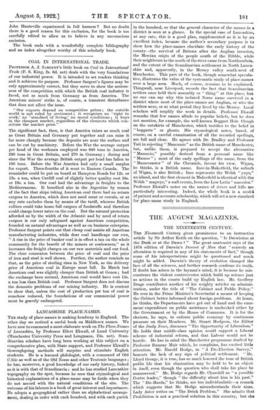LANCASHIRE PLACE-NAMES.
THE study of place-names is making headway in England. The other day we noticed a useful book on Middlesex names. We have now to commend a most elaborate work on The Place-Names of Lancashire, by Professor Eilert Ekwa,ll, of Lund University (Manchester University Press and Longmans, 25s. net). Scan- dinavian scholars have long been working at this subject on a comprehensive plan, with State support, and Professor Ekwall's thoroughgoing methods will surprise and stimulate English students. He is a learned philologist, with a command of Old CAtic as well as of the Old Norse and other Teutonic languages ; he has, moreover, a good knowledge of our early history, linked 118 it is with that of Scandinavia ; and he has studied Lancashire topography on the spot, because he sees that etymological and historical explanations of a place-name may be futile when they do not accord with the natural conditions of the site. The outcome of his labours is a book of great interest and importance. He adopts a geographical rather than an alphabetical arrange- ment, dealing in order with each hundred, and with each parish in the hundred, so that the general character of the names in a district is seen at a glance. In the special case of Lancashire, at any rate, this is a good plan, supplemented as it is by .an excellent index, because the author's secondary purpose is to show how the place-names elucidate the early history of the county—the survival of Britons after the Anglian invasion, the Mercian origin of the people south of the Ribble, while their neighbours to the north of the river came from Northumbria, and the extent of the Scandinavian settlement in North Lanca- shire and, apparently, in the Mersey valley south-west of Manchester. This part of the book, though somewhat specula- tive, illustrates the value of the systematic study of place-names over a large area. Much, of course, remains to be explained. Thingwall, near Liverpool, records the fact that Scandinavian settlers once held their assembly or " thing " at this place, but no one can say why this isolated Norse name survived in a district where most of the place-names are Anglian, or who the settlers were, or at what period they lived by the Mersey. Local scholars will amplify the work in details. Professor Ekwall remarks that few names allude to popular beliefs, but he does not mention, for example, the well-known Boggart Hole Clough on the outskirts of Manchester, which testifies to the belief in " boggarts " or ghosts. His etymological notes, based, of course, on a careful examination of all the recorded spellings, are full and clear. He agrees with Dr. Bradley and Professor Tait in rejecting " Mancunio" as the British name of Manchester, but, unlike them, is prepared to accept the alternative " Mamucio," possibly derived from a personal name like " Mamus " ; most of the early spellings of the name, from the " Mameceaster " of the Chronicle, favour his view. Wigan, he thinks, is a British name. Ince-in-Makerfield, the suburb of Wigan, is also British ; Inc,e represents the Welsh " ynys," an island, and the first element in Makerfield is identical with the Welsh" ma.gwyr," a wall or ruin, from the Low Latin" maceries." Professor Ekwall's notes on the names of rivers and hills am particularly interesting. Indeed, the whole book is a model of patient and accurate scholarship, which will set a new standard for place-name study in England.


































 Previous page
Previous page